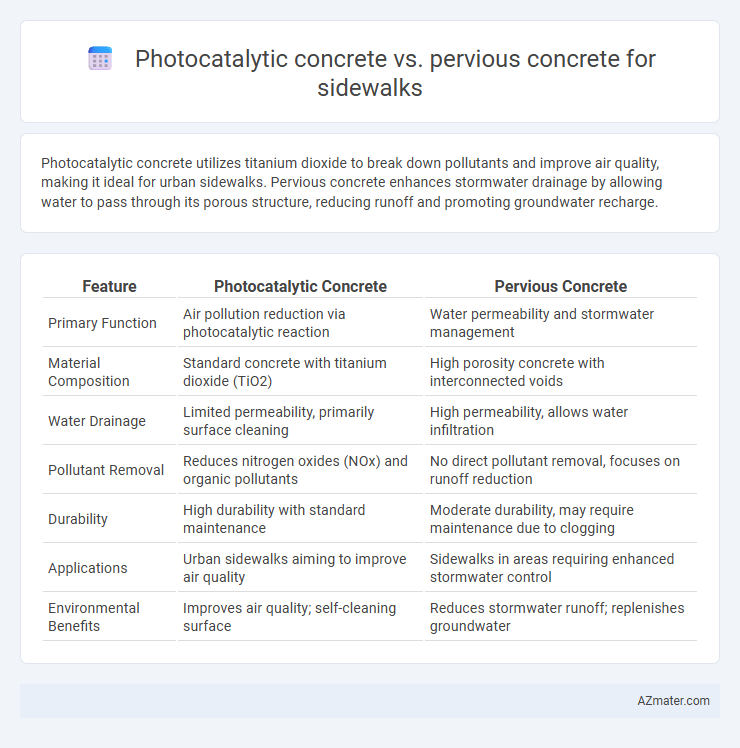Photocatalytic concrete utilizes titanium dioxide to break down pollutants and improve air quality, making it ideal for urban sidewalks. Pervious concrete enhances stormwater drainage by allowing water to pass through its porous structure, reducing runoff and promoting groundwater recharge.
Table of Comparison
| Feature | Photocatalytic Concrete | Pervious Concrete |
|---|---|---|
| Primary Function | Air pollution reduction via photocatalytic reaction | Water permeability and stormwater management |
| Material Composition | Standard concrete with titanium dioxide (TiO2) | High porosity concrete with interconnected voids |
| Water Drainage | Limited permeability, primarily surface cleaning | High permeability, allows water infiltration |
| Pollutant Removal | Reduces nitrogen oxides (NOx) and organic pollutants | No direct pollutant removal, focuses on runoff reduction |
| Durability | High durability with standard maintenance | Moderate durability, may require maintenance due to clogging |
| Applications | Urban sidewalks aiming to improve air quality | Sidewalks in areas requiring enhanced stormwater control |
| Environmental Benefits | Improves air quality; self-cleaning surface | Reduces stormwater runoff; replenishes groundwater |
Introduction to Photocatalytic and Pervious Concrete
Photocatalytic concrete incorporates titanium dioxide, enabling it to break down pollutants and improve air quality through light-activated chemical reactions. Pervious concrete features a porous structure that allows water to penetrate, reducing surface runoff and enhancing groundwater recharge. Both materials offer sustainable solutions for sidewalks, with photocatalytic concrete targeting air purification and pervious concrete focusing on stormwater management.
Key Material Properties Comparison
Photocatalytic concrete incorporates titanium dioxide, enabling self-cleaning and air-purifying properties by breaking down pollutants on the surface, whereas pervious concrete features a high porosity structure designed for enhanced water permeability and stormwater management. Photocatalytic concrete exhibits lower permeability but excels in environmental remediation, whereas pervious concrete facilitates rapid drainage, reducing runoff and improving ground water recharge. Mechanical strength in photocatalytic concrete is typically higher due to its dense matrix, while pervious concrete sacrifices some strength for porosity, making material selection a balance between durability, environmental impact, and functionality for sidewalk applications.
Environmental Benefits: Air and Water Quality
Photocatalytic concrete improves air quality by breaking down pollutants such as nitrogen oxides and volatile organic compounds through photocatalysis, effectively reducing urban smog and harmful airborne particles. Pervious concrete enhances water quality by allowing rainwater to infiltrate through the sidewalk surface, filtering pollutants and recharging groundwater, thereby reducing stormwater runoff and associated contamination. Both materials contribute to sustainable urban environments by targeting key environmental issues: photocatalytic concrete addresses air pollution, while pervious concrete mitigates water pollution and promotes natural hydrological cycles.
Durability and Maintenance Requirements
Photocatalytic concrete offers superior durability by actively breaking down pollutants and organic matter on its surface, reducing wear and staining over time, whereas pervious concrete is more prone to clogging and structural weakening due to debris accumulation. Maintenance for photocatalytic concrete is generally lower, requiring only periodic rinsing to maintain its self-cleaning properties, while pervious concrete demands frequent inspections and cleaning to prevent pore blockage and preserve permeability. Both materials enhance sustainability, but photocatalytic concrete provides a longer-lasting sidewalk solution with reduced upkeep compared to the more maintenance-intensive pervious concrete.
Installation Process and Costs
Photocatalytic concrete involves integrating titanium dioxide into the mix, which requires specialized materials and precise mixing techniques, often leading to higher installation costs compared to pervious concrete. Pervious concrete installation demands careful layering and compaction to ensure adequate permeability, with costs primarily driven by site preparation and material grades. Although photocatalytic concrete provides self-cleaning and pollutant-reducing benefits, pervious concrete generally offers more cost-effective installation and improved stormwater management for sidewalks.
Performance in Urban Environments
Photocatalytic concrete enhances urban air quality by breaking down pollutants through titanium dioxide activation, making it highly effective in reducing smog and vehicle emissions along sidewalks. Pervious concrete excels in managing stormwater runoff by allowing rapid infiltration, thus minimizing urban flooding and surface water pollution during heavy rain events. While photocatalytic concrete targets atmospheric pollutant degradation, pervious concrete primarily improves water permeability and reduces heat island effects, each offering complementary benefits for sustainable urban sidewalk performance.
Aesthetic and Design Flexibility
Photocatalytic concrete offers enhanced aesthetic appeal through its self-cleaning properties that reduce surface stains and maintain a bright, clean appearance over time, making it ideal for visually appealing sidewalks. Pervious concrete allows for versatile design options with varied textures and patterns that improve water permeability, enhancing environmental integration without compromising on customization. Both materials provide unique design flexibility, but photocatalytic concrete primarily emphasizes durability and cleanliness, while pervious concrete enhances natural water flow and landscaping compatibility.
Safety Features and Accessibility
Photocatalytic concrete enhances sidewalk safety by reducing air pollutants and preventing surface grime, resulting in cleaner, less slippery walkways that minimize slip-and-fall accidents. Pervious concrete improves accessibility by allowing water to infiltrate, reducing puddling and hydroplaning risks, which supports wheelchair and stroller mobility with stable, non-slip surfaces. Both materials contribute to safer pedestrian environments, with photocatalytic concrete focusing on surface cleanliness and pervious concrete on effective drainage and slip resistance.
Sustainability and Long-Term Benefits
Photocatalytic concrete enhances sustainability by actively reducing air pollution through the decomposition of harmful pollutants, improving urban air quality over time. Pervious concrete promotes long-term environmental benefits by enabling natural groundwater recharge and reducing stormwater runoff, thereby mitigating flooding and erosion risks. Both materials contribute to sustainable sidewalk design, with photocatalytic concrete focusing on air purification and pervious concrete on effective water management.
Which Concrete is Best for Sidewalk Applications?
Photocatalytic concrete offers superior air-purifying properties by breaking down pollutants and reducing nitrogen oxides, making it ideal for urban sidewalks with heavy traffic pollution. Pervious concrete excels at stormwater management through high permeability, reducing runoff and improving groundwater recharge, suited for areas with frequent rainfall and flooding concerns. For sidewalk applications prioritizing environmental impact and air quality, photocatalytic concrete is best, while pervious concrete is optimal for enhancing water drainage and preventing surface water accumulation.

Infographic: Photocatalytic concrete vs Pervious concrete for Sidewalk
 azmater.com
azmater.com